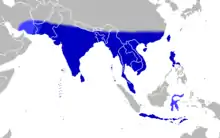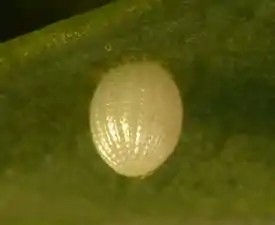Tirumala limniace
Tirumala limniace, the blue tiger,[1][2] is a butterfly found in South Asia and Southeast Asia[1][2] that belongs to the crows and tigers, that is, the danaid group of the brush-footed butterfly family. This butterfly shows gregarious migratory behaviour in southern India.
| Blue tiger | |
|---|---|
.jpg.webp) | |
_male_underside.jpg.webp) | |
| Underside of male both in Kerala, India | |
| Scientific classification | |
| Kingdom: | Animalia |
| Phylum: | Arthropoda |
| Class: | Insecta |
| Order: | Lepidoptera |
| Family: | Nymphalidae |
| Genus: | Tirumala |
| Species: | T. limniace |
| Binomial name | |
| Tirumala limniace (Cramer, [1775]) | |
| Subspecies | |
|
See text | |
 | |
| Synonyms | |
| |
Description
In general, all butterflies can directly absorb heat from the sun via their wings to facilitate autonomous flight. Studies on blue tiger butterflies show that high-intensity light significantly increased flight activity. Blue tiger butterflies have a wing surface color that is composed of both light and dark colors. The dark areas on the wing surfaces are the heat absorption areas that allow for the facilitation of autonomous flight.
Life cycle
Food plants
The butterfly larva generally feed on plants of family Asclepiadaceae. The recorded host plants are:
- Asclepias
- Calotropis
- Heterostemma
- Marsdenia
- Dregea volubilis
- Heterostemma cuspidatum
- Hoya viridiflora
- Marsdenia tenacissima
- Crotalaria spp.
- Epibaterium spp.
- Soya[3]
Larva
Yellowish white; 3rd and 12th segments, each with a pair of fleshy filaments, black and greenish white; each of the segments with four transverse black bars, the second bar on all broader than the others, bifurcated laterally, a yellow longitudinal line on each side; head, feet and claspers spotted with black.[3] The larva is around 1.21 centimetres (0.48 in) in length and weighs around 5 milligrams (0.077 gr) initially, but grows double that size and four times that weight within 48 hours.
Pupa
"Green with golden scattered spots and beaded dorsal crescent". (Frederic Moore quoted in Bingham)[3]
Range
The species is distributed in South Asia and Southeast Asia.[1][2] In 2019, a single adult specimen was reported from the Balearic Islands, marking it the first record of the species in Europe.[4]
Subspecies
Listed alphabetically:[2]
- T. l. bentenga (Martin, 1910) – Selajar
- T. l. conjuncta Moore, 1883 – Java, Bali, Kangean, Bawean, Lesser Sunda Islands
- T. l. exotica (Gmelin, 1790) – United Arab Emirates
- T. l. ino (Butler, 1871) – Sula
- T. l. leopardus (Butler, 1866) – Ceylon, India - southern Burma
- T. l. limniace (Cramer, [1775]) – southern China, Indochina, Hainan, Taiwan
- T. l. makassara (Martin, 1910) – southern Sulawesi
- T. l. orestilla (Fruhstorfer, 1910) – Philippines (Luzon)
- T. l. vaneeckeni (Bryk, 1937) – Timor, Wetar
Habits
This species migrates extensively during the monsoons in southern India. The migratory populations have been observed to consist nearly entirely of males.[5] It is also known to mud-puddle during migration.[6]
Gallery of life cycle
 Egg
Egg_%E2%80%93_Blue_Tiger_found_in_the_backside_of_the_Wattakaka_volubilis_leaf_WLB_DSC_0257.jpg.webp)
 Larva
Larva_%E2%80%93_Blue_Tiger_WLB_WP_20160826_12_05_55_Pro.jpg.webp)
 Pupa
Pupa_on_Heliotropium_indicum_W_IMG_9940.jpg.webp)
 Congregating with a common crow in Kolkata, West Bengal, India
Congregating with a common crow in Kolkata, West Bengal, India
References
- Varshney, R.K.; Smetacek, Peter (2015). A Synoptic Catalogue of the Butterflies of India. New Delhi: Butterfly Research Centre, Bhimtal & Indinov Publishing. doi:10.13140/RG.2.1.3966.2164. ISBN 978-81-929826-4-9.
- Savela, Markku. "Tirumala limniace (Cramer, [1775])". Lepidoptera and Some Other Life Forms. Retrieved July 3, 2018.
-
 One or more of the preceding sentences incorporates text from a work now in the public domain: Bingham, Charles Thomas (1907). Fauna of British India. Butterflies Vol. 2. Taylor & Francis. p. 16.
One or more of the preceding sentences incorporates text from a work now in the public domain: Bingham, Charles Thomas (1907). Fauna of British India. Butterflies Vol. 2. Taylor & Francis. p. 16.
- Truyols-Henares, Francisco; Febrer-Serra, Maria; Lassnig, Nil; Perelló, Esperanza; Medina-Torrecabota, Mercedes; Pinya, Samuel (2019). "From Asia to Europe: The first record of the blue tiger Tirumala limniace (Cramer, [1775]) (Lepidoptera: Nymphalidae: Danainae) in the European continent". Journal of Asia-Pacific Entomology. 22 (4): 1187–1188. doi:10.1016/j.aspen.2019.10.011.
- Kunte, Krushnamegh (2005). "Species composition, sex-ratios and movement patterns in Danaine butterfly migrations in southern India". Journal of the Bombay Natural History Society. 102 (3): 280–286.
- Mathew, G.; Binoy, C.F. (2002). "Migration of butterflies (Lepidoptera: Rhopalocera) in the New Amarambalam Reserve Forest of the Nilgiri Biosphere Reserve" (PDF). Zoos' Print Journal. 17 (8): 844–847. doi:10.11609/jott.zpj.17.8.844-7.
External links
| Wikimedia Commons has media related to Tirumala limniace. |